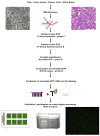Viruses and kidney disease: beyond HIV
- PMID: 19013331
- PMCID: PMC2629127
- DOI: 10.1016/j.semnephrol.2008.08.010
Viruses and kidney disease: beyond HIV
Abstract
Human immunodeficiency virus (HIV)-infected patients may acquire new viral co-infections; they also may experience the reactivation or worsening of existing viral infections, including active, smoldering, or latent infections. HIV-infected patients may be predisposed to these viral infections owing to immunodeficiency or risk factors common to HIV and other viruses. A number of these affect the kidney, either by direct infection or by deposition of immune complexes. In this review we discuss the renal manifestations and treatment of hepatitis C virus, BK virus, adenovirus, cytomegalovirus, and parvovirus B19 in patients with HIV disease. We also discuss an approach to the identification of new viral renal pathogens, using a viral gene chip to identify viral DNA or RNA.
Figures


References
-
- Broers B, Junet C, Bourquin M, Deglon JJ, Perrin L, Hirschel B. Prevalence and incidence rate of HIV, hepatitis B and C among drug users on methadone maintenance treatment in Geneva between 1988 and 1995. AIDS (London, England) 1998;12:2059–2066. - PubMed
-
- Sulkowski MS, Mast EE, Seeff LB, Thomas DL. Hepatitis C virus infection as an opportunistic disease in persons infected with human immunodeficiency virus. Clin Infect Dis. 2000;30(Suppl 1):S77–84. - PubMed
-
- Davda R, Peterson J, Weiner R, Croker B, Lau JY. Membranous glomerulonephritis in association with hepatitis C virus infection. Am J Kidney Dis. 1993;22:452–455. - PubMed
-
- Stehman-Breen C, Alpers CE, Couser WG, Willson R, Johnson RJ. Hepatitis C virus associated membranous glomerulonephritis. Clin Nephrol. 1995;44:141–147. - PubMed
-
- Sabry A, El-Agroudy A, Sheashaa H, et al. Histological characterization of HCV-associated glomerulopathy in Egyptian patients. Int Urol Nephrol. 2005;37:355–361. - PubMed
Publication types
MeSH terms
Substances
Grants and funding
LinkOut - more resources
Full Text Sources
Medical

